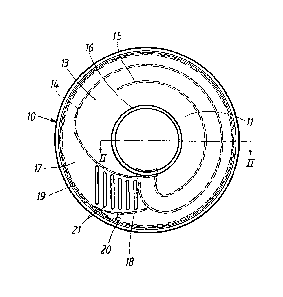Une partie des informations de ce site Web a été fournie par des sources externes. Le gouvernement du Canada n'assume aucune responsabilité concernant la précision, l'actualité ou la fiabilité des informations fournies par les sources externes. Les utilisateurs qui désirent employer cette information devraient consulter directement la source des informations. Le contenu fourni par les sources externes n'est pas assujetti aux exigences sur les langues officielles, la protection des renseignements personnels et l'accessibilité.
L'apparition de différences dans le texte et l'image des Revendications et de l'Abrégé dépend du moment auquel le document est publié. Les textes des Revendications et de l'Abrégé sont affichés :
| (12) Brevet: | (11) CA 1316846 |
|---|---|
| (21) Numéro de la demande: | 1316846 |
| (54) Titre français: | FERMETURE DE BOUT POUR CONTENANT |
| (54) Titre anglais: | END CLOSURE FOR A PACKAGING CONTAINER |
| Statut: | Périmé et au-delà du délai pour l’annulation |
| (51) Classification internationale des brevets (CIB): |
|
|---|---|
| (72) Inventeurs : |
|
| (73) Titulaires : |
|
| (71) Demandeurs : |
|
| (74) Agent: | MARKS & CLERK |
| (74) Co-agent: | |
| (45) Délivré: | 1993-04-27 |
| (22) Date de dépôt: | 1989-02-14 |
| Licence disponible: | S.O. |
| Cédé au domaine public: | S.O. |
| (25) Langue des documents déposés: | Anglais |
| Traité de coopération en matière de brevets (PCT): | Non |
|---|
| (30) Données de priorité de la demande: | ||||||
|---|---|---|---|---|---|---|
|
ABSTRACT
An end closure for a packaging container where the closure is
of the basic type having a so called one step opening arrange-
ment, i.e. where an outer layer and an inner layer are
removed in unison or simultaneously by shaping the tearing
denotations in a proper pattern.
In order to provide an opening procedure giving less splash
the outer layer is divided into a central part having a grip
for individually removing the central part from the inner
layer laying under the outer layer without being connected
thereto.
A circumferentially extending region all around the closure,
is defined by said circumferential tearing denotation and the
central part and is removable together with the inner layer
inside the tearing denotation.
Note : Les revendications sont présentées dans la langue officielle dans laquelle elles ont été soumises.
Note : Les descriptions sont présentées dans la langue officielle dans laquelle elles ont été soumises.

2024-08-01 : Dans le cadre de la transition vers les Brevets de nouvelle génération (BNG), la base de données sur les brevets canadiens (BDBC) contient désormais un Historique d'événement plus détaillé, qui reproduit le Journal des événements de notre nouvelle solution interne.
Veuillez noter que les événements débutant par « Inactive : » se réfèrent à des événements qui ne sont plus utilisés dans notre nouvelle solution interne.
Pour une meilleure compréhension de l'état de la demande ou brevet qui figure sur cette page, la rubrique Mise en garde , et les descriptions de Brevet , Historique d'événement , Taxes périodiques et Historique des paiements devraient être consultées.
| Description | Date |
|---|---|
| Inactive : CIB de MCD | 2006-03-11 |
| Inactive : CIB de MCD | 2006-03-11 |
| Inactive : Demande ad hoc documentée | 1996-04-27 |
| Le délai pour l'annulation est expiré | 1995-10-29 |
| Lettre envoyée | 1995-04-27 |
| Accordé par délivrance | 1993-04-27 |
Il n'y a pas d'historique d'abandonnement
Les titulaires actuels et antérieures au dossier sont affichés en ordre alphabétique.
| Titulaires actuels au dossier |
|---|
| PATRIK DUVANDER |
| KENT JOHANSSON |
| AB AKERLUND & RAUSING |
| Titulaires antérieures au dossier |
|---|
| S.O. |